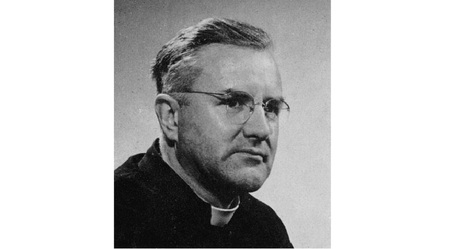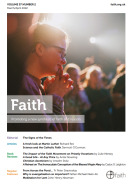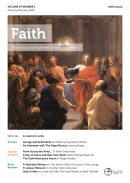Featured
The Faith Movement: a time of renewal
The Faith Movement has a joyful understanding of God and the mission of the Church, seeing Christ as the Lord of History and recognising that He has a special call to men and women of each era, including our own.
Iraq: Miracles do happen

The Angel's Salutation

Richard Conrad OP reflects on the Angel’s salutation to Mary (Luke 1: 26-38)
FROM ACROSS THE POND

Is Freedom of Religion or Belief now politically mainstream?

Mgr Michael Nazir Ali on a conference on a crucial theme
Holloway on - The Character of Christ

Holloway on the character of Christ
Sexual abuse and the gay clergy subculture

Ireland's loss of faith

The Rise and Fall of Christian Ireland by Crawford Gribben, Oxford University Press, 352pp,
£25.00. Review by Peter Guilding
The need for Newman?s theory of development

A seventeenth century Jesuit in Goa

-
The Faith Movement: a time of renewal
“When we look up at the limitless heavens and meditate on the creation of it all, we are struck by the mysteries of His greatness” – thus Benedict VI, speaking to astronauts orbiting the earth.1
The Faith Movement has a joyful understanding of God and the mission of the Church, seeing Christ as the Lord of History and recognising that He has a special call to men and women of each era, including our own.
The Book of Genesis explains that “in the beginning”2 God made the heavens and the earth. And he made man, and all was in harmony: God with man, man with God and with all creation, and with himself. And God did not allow man to be lonely, so “male and female he created them”: there was partnership, there was mutual need fulfilled, there was human community. 3
And man sinned. Augustine teaches that when man sinned, he inflicted a wound upon himself that would then be transmitted, through sexual union and the begetting of children, to each new generation. Man’s sin changed everything: making human will feeble although not actually destroying it, breaking the previously open and easy relationship with God, damaging man’s essential nature. And all children born inherit this Original Sin: “For God, the author of natures, created man upright; but man, being of his own will corrupted, and justly condemned, begot corrupted and condemned children.”(Augustine) 4
Augustine is also clear that the solution to this lies not with our initiative but with God: he has not broken with us and his love for his creation is just as it was in the beginning. He will act to ensure that his beloved human beings are not left in this darkness: our task is to respond to that love, and to do so in complete confidence and with the certainty of the initiative being his and of a need in us to respond to it. God calls us: we answer. We do not – contrary to the teachings of Pelagius – get right with God by our own efforts, by willpower and putting our best efforts into it, but by trusting in God and responding fully to him.
Augustine lived in the 4 th century and taught and wrote while the Roman Empire was collapsing (d.430). Thomas Aquinas lived six centuries later (1225-1274) and he followed Augustine’s doctrines, bringing new insights to them.
Aquinas saw Adam and Eve as living in original justice with God. There was, as it were, a bond that went directly from God to them, with everything in perfect co-ordination: a chain that hangs true, like a plumb-line, absolutely straight and absolutely to be trusted, with God at the top and communication fully functioning all the way. Had Adam not sinned, that perfect co-ordination would have continued from generation to generation, with God serenely in charge and man serenely co-operating with him.
Aquinas thus refines Augustine’s teachings. And in describing what happens when man sins, Aquinas shows that it breaks this direct link, this plumb-line, and deprives all future human beings of the gifts with which Adam and Eve had been endowed by God. Human beings are now less than they were: but they are still human, created and loved by God, and greatly capable of loving him in return. Grace will now be needed to lift humanity up, and to heal the sinfulness.
Aquinas is not grappling with Pelagius and writes with greater serenity than does Augustine, although still with vigour. Man’s sin was that of pride, and a desire to be like God in having knowledge of things and fore-knowledge of the future.
The Church today teaches what both Augustine and Aquinas taught and believed: that Original Sin is “a deprivation of original holiness and justice, but human nature has not been totally corrupted: it is wounded in the natural powers proper to it, subject to ignorance, suffering and the dominion of death, and inclined to sin – an inclination to evil that is called ‘concupiscence’.” (Catechism of the Catholic Church). 5
Today, we may read the story of Genesis and note that in its concept of God creating things over a period of time there could be an indication of an evolutionary process, ordered and directed by the Divine hand. We could note that we certainly feel the effects on Original Sin in concupiscence in our own lives – and not least in the area of sexual union. We might also note that the centuries which have passed since Augustine’s day have not all been kind to his memory – the Church has often, and sometimes with justice, been accused of over-emphasising the wickedness of sexual sin over the wickedness of other sins, because of some deeply-held conviction that there is something Genesis-orientated about it and because it is connected with the transmission of life itself.
Our current knowledge of human origins certainly encourages us to assume that the world is extremely old, and that human beings arrived on it following a lengthy process, some of which we can track by studying fossils and geology.
“To look at the embryos of a fish, a chick, a calf and a man reveals an obvious likeness that could hardly be a coincidence. Then again, the likeness in the chemical structure of the cells of living things, combined with the study of genetics and of plant and animal classification linked to the fossil records (palaeontology), provides overwhelming support for the fact of evolution. And when the physical and chemical laws which are found to operate in the living things are the same as those in the non-living world, then the pieces fit together and evolutionis seen to be a process that cannot be limited to the living world only but must embrace the Universe as a whole” (Roger Nesbitt, Evolution and the Existence of God). 6
Evolution
In the 19 th and early 20 th centuries the debates about evolution – initiated by Charles Darwin and his discoveries – made many Christians wary. The Church seemed uncomfortable with Darwin’s work and there is a defensive tone to much of what was written by Christians on this subject at that time. But not all: John Henry Newman wrote in 1868 that “the theory of Darwin, true or not, is not necessarily atheistic; on the contrary, it may simply be suggesting a larger idea of divine providence and skill.” 7
In 1996, John Paul II told the Pontifical Academy of Sciences that “new scientific knowledge has led us to the conclusion that the theory of evolution is no longer a mere hypothesis.” 8
Pope Benedict XVI (as Cardinal Joseph Ratzinger), suggested that “we cannot say creation or evolution, inasmuch as these two things respond to two different realities. The story of the dust of the God...does not in fact explain how human persons came to be but rather what they are.” 9 And in July 2007, addressing a clergy conference as Pope he noted that it was wrong to present “creationism” and evolutionism as two mutually exclusive alternatives: “This antithesis is absurd because, on the one hand, there are so many scientific proofs in favour of evolution which appears to be a reality we can see and which enriches our knowledge of life and being as such. But on the other, the doctrine of evolution does not answer every query, especially the great philosophical question: where does everything come from? And how did everything start which ultimately led to man?” 10
The Catechism of the Catholic Church (1994) speaks of the Church “interpreting the symbolism of biblical language in an authentic way” 11 . It states that “The first man was not only created good, but was also established in friendship with his Creator and in harmony with himself and with the creation around him, in s state that would be surpassed only by the glory of the new creation in Christ.” 12
And it is seeing things through the perspective of Christ that provides the key. “As Christians we read the Holy Scripture with Christ...he is freedom from a false slavery to literalism and a guarantee of the solid, realistic truth of the Bible, which does not dissipate into a cloud of pious pleasantries but remains the sure ground on which we can stand.” (Benedict XVI) 13 “Jesus Christ, the Redeemer of Man, is the centre and purpose of human history.” (Redemptor Hominis) 14
The Catechism of the Catholic Church notes that “The account of the fall in Genesis 3 uses figurative language, but affirms a primeval event, a deed that took placed at the beginning of the history of man.” 15
Man’s fall, as understood by Augustine and Aquinas and taught consistently by the Church down the ages, did not mean that God was thus angry and had to be placated. On the contrary: when he sent his Son it was because of love. He seeks to renew the bond of love with mankind, and he never ceases to do this. “Even when he disobeyed you and lost your friendship, you did not abandon him to the power of death, but helped all men to seek and find you....” (Eucharistic prayer IV)
Nor was the Incarnation a sort of “rescue mission”. God’s Word was there “in the beginning” and the Gospel of St John tells us that this Word was always with God and was God. When “the Word became flesh and dwelt amongst us” 16 it was not because there had been a mistake in God’s original plan: he had always wanted to be close to his beloved creatures. Because of man’s sin, the Incarnation now took place under different circumstances. But the love was the same, and the Word found a safe and pure dwelling in the sinless womb of the Virgin Mary, just as the first Adam had found a safe home on the then-sinless earth.
Through Christ we can be healed, and it is a truly powerful healing. Through Adam’s sin, death had entered into the world, but through Christ’s death on the Cross, and his Resurrection, something new is achieved and we can say with the Scriptures “O Death, where is your sting/ Where, grave, your victory?” 17
But today, discussion of an authentic Catholic teaching on Original Sin must not only take account of our current knowledge of human origins – our discoveries about evolution, fossils, human biology, and more – but also current ideas and controversies over human behaviour, the relationship between men and women, and the meaning and purpose of human sexuality.
These would not have been issues in, for example, John Henry Newman’s day, or even fifty years ago. But today the introduction of the topic of Original Sin is likely to elicit a reaction such as “Oh, this’ll be the Catholic Church with its obsession with sexual sins” or – on a slightly different tack – “Why does the Catholic Church have such an odd attitude to women?”
Theology of the Body
Whether we like it or not, we need to tackle this – and in being obliged to do so, we may find new insights.
We might first make the point that in an age when sexual union and the transmission of life are seen as two unconnected things – a division which is causing a great deal of human sadness, collapse of family life, and concomitant financial and social difficulties – this might be a discussion worth having. We do know a lot today about human origins, human reproduction, and the workings of the human body, but we have also lost sight of some very basic truths as we struggle to convince ourselves that two people of the same sex can get married or that in-vitro fertilisation raises no moral questions, or that teenagers should be given contraceptives and encouraged to experiment sexually. Perhaps a very realistic grasp of what sexual union is for, its biological reality, has more value than modern critics will initially acknowledge.
It will probably also be useful to note that John Paul II’s Mulieris Dignitatem 18 brought insights that answer feminist criticisms and highlight the truth of the Church's constantrecognition of the profoundly spiritual importance of motherhood, centred on an understanding of the Church as Mother.
New insights
This does not mean that we need to modify Augustine and Aquinas to fit in with modern feminism, but merely that we should accept that we might usefully expect new insights into this aspect of their writings in the light of modern knowledge of the human body and of human reproduction. John Paul II’s Theology of the Body will give us some insights here 19 .
This will not impress enthusiastic Thomists, who argue that we should take things from a completely different angle. Rather than answer critics of Augustine and Aquinas we should offer a “postmodern Augustinian Thomism” which emphasises “the symphonic harmony of the faculties of the soul, including the neglected faculty of the memory and the harmony of the community based on an identity shaped by a narrative tradition, and an ethos concerned for the common good” (Rowland) 20 . Enthusiasts suggest that “the post-Conciliar generation lived through the institutional embodiment of the principles behind the attempted rapprochement with the Liberal tradition and have concluded that such strategies did nothing to convert Liberals to Christianity but certainly succeeded in causing widespread confusion among the laity, and the secularisation of the Church’s pastoral work.” (Rowland again). 21
But this is to assume that only the opinions of an immediate post-Vatican II generation are relevant. We are beyond that now, and the Council’s documents are being recognised in new ways. Vatican II’s Gaudium et Spes offers a different vision of engagement with the modern world and suggests that it could be positive, enriching, and full of opportunities for spreading the Gospel. The Church is larger – much larger – than the confusion among 1970s/80s Catholics of Europe/America/Australia. There are now something like 1.196 billion Catholics in the world, many (most?) of them not particularly connected with tensions of 50 years ago, but influenced by subsequent events, dramas, teachings and adventures in the life of the Church – not least in Africa and Asia, where the Church has seen substantial growth.
The Faith Movement offers its own specific contribution, seen through the perspective of an authentic understanding of evolution, and enriched by a recognition that the Church is renewed again and again by God, revealing the truth to new generations in accordance with the Divine plan.
We believe that as we head for the third decade of the third Millennium, we can offer a message that is joy-filled and confident, with insights and coherence that capture minds and hearts. Over the past half-century, a good number of young men and women have been formed and taught through the Faith Movement, and made their own contribution to the life of the Church. In recent years the grandchildren of some of the early Faith Movement members have been attending the summer events and gatherings. As this issue goes to press, plans for 2023 are under way. Ad multos annos.
1. Pope Benedict XVI, speaking to astronauts on a live TV-link, May 21 st , 2011
5. Catechism of the Catholic Church. No.3405. Geoffrey Chapman, London, 1994, page 91
6. Nesbitt, Roger. Evolution and the Existence of God, Catholic Truth Society, London, 1971, page 2.
8. John Paul II, Oct 22 nd 1996
10. Pope Benedict XVI, addressing clergy of Belluno-Feltre and Treviso, July 24 th , 2007.
11. Catechism of the Catholic Church. No.375. Geoffrey Chapman, London, 1994, page 85.
12. Catechism of the Catholic Church. No.374. Geoffrey Chapman, London, 1994, page 85.
14. Opening words of Redemptor Hominis, encyclical letter of John Paul II, 1979. Vatican website.
15. Catechism of the Catholic Church. No.390. Geoffrey Chapman, London, 1994, page 87


















